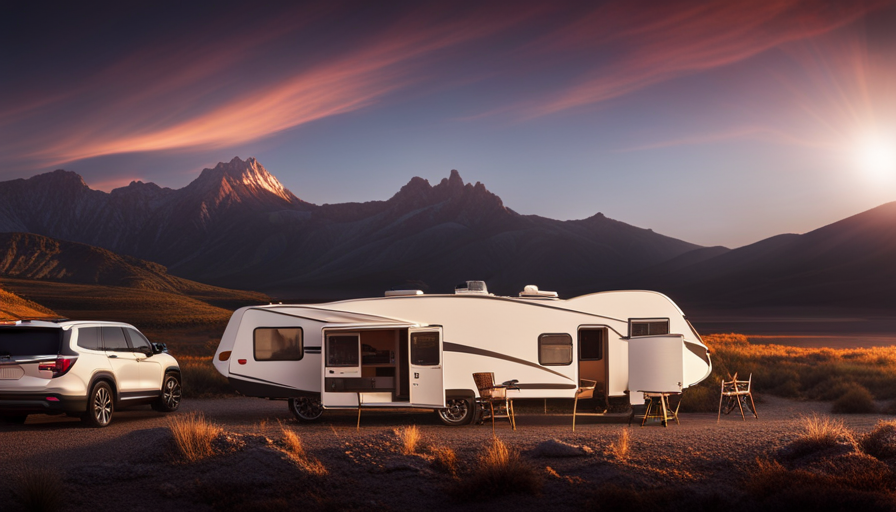If you own a Honda Pilot and want to take a camper on your next road trip, you’re in luck! We have all the details you need on what size camper your Honda Pilot can safely tow.
Now, you might think that a Honda Pilot, being a midsize SUV, wouldn’t be able to handle towing a camper. But let me tell you, you’d be surprised! The Honda Pilot is actually quite capable when it comes to towing, and with the right setup, it can handle a camper of a decent size.
In this article, we’ll walk you through everything you need to consider when determining what size camper your Honda Pilot can pull. From understanding towing capacity and weight limits to evaluating tongue weight and hitch requirements, we’ve got you covered.
So sit back, relax, and get ready to hit the road with your trusty Honda Pilot and your dream camper in tow. Let’s get started!
Key Takeaways
- The towing capacity of a Honda Pilot ranges from 3,500 to 5,000 pounds, so it is important to determine the weight of the camper to ensure it falls within the vehicle’s capabilities.
- Proper weight distribution is crucial for stability and control while towing, and it is recommended to use a weight distribution hitch.
- It is important to consult the Honda Pilot’s owner’s manual for specific towing capacity and weight distribution guidelines, as well as information on trailer weight restrictions and GVWR.
- Towing a camper that exceeds the vehicle’s towing capacity can strain the engine, transmission, and brakes, potentially causing damage to the vehicle.
Understanding Towing Capacity and Weight Limits
You’ll be amazed at how much you can tow with your Honda Pilot! Understanding the towing capacity limits and weight distribution considerations is essential when it comes to towing a camper with your Honda Pilot.
The towing capacity of your Honda Pilot depends on the model and configuration you have. Generally, the Honda Pilot has a towing capacity ranging from 3,500 to 5,000 pounds, which should be sufficient for towing a small to mid-size camper.
When considering towing capacity limits, it is important to factor in the weight of the camper and any additional cargo you may be carrying. You should never exceed the maximum towing capacity specified by Honda for your specific model. Exceeding this limit can put unnecessary strain on your vehicle’s engine, transmission, and brakes, potentially leading to mechanical issues.
Weight distribution is another crucial consideration when towing a camper. Properly distributing the weight of the camper and any cargo will help maintain stability and control while towing. It’s recommended to use a weight distribution hitch to evenly distribute the weight between the Honda Pilot and the camper.
To determine the exact towing capacity and weight distribution specifications for your Honda Pilot, it’s always best to consult your Honda Pilot’s owner’s manual. It provides detailed information and guidelines specific to your vehicle, ensuring you tow safely and within the recommended limits.
Consult Your Honda Pilot’s Owner’s Manual
Discover the valuable information in your Honda Pilot’s owner’s manual, which provides guidance on the appropriate towing capabilities. The owner’s manual is a comprehensive resource that outlines the towing capacity guidelines and trailer weight restrictions specific to your vehicle. It is essential to consult this manual before attempting to tow any trailer or camper with your Honda Pilot.
The owner’s manual will provide you with the precise towing capacity for your Honda Pilot based on its specific model and configuration. It will also outline the maximum trailer weight restrictions that you should adhere to in order to ensure safe and efficient towing. By following these guidelines, you can ensure that you’re not exceeding the limits of your vehicle and risking any potential damage or safety hazards.
In addition to the towing capacity guidelines and trailer weight restrictions, the owner’s manual will also provide you with information about the gross vehicle weight rating (GVWR). This rating indicates the maximum weight that your Honda Pilot can safely carry, including passengers, cargo, and the weight of the trailer being towed. Understanding the GVWR is important as it helps you determine the overall weight limitations of your vehicle and ensures that you’re towing within its capabilities.
Consider the gross vehicle weight rating (GVWR) when determining the appropriate size camper that your Honda Pilot can pull. Also, take into account the specific towing capabilities of your Honda Pilot, as this will also play a significant role in safely pulling a camper. It’s important to never exceed the truck towing capacity for 30ft camper as recommended by the manufacturer to avoid causing damage to your vehicle and compromising safety on the road. Be sure to consult your vehicle’s manual or a trusted automotive expert to determine the maximum weight your Honda Pilot can safely tow.
Consider the Gross Vehicle Weight Rating (GVWR)
When considering the GVWR, it’s crucial to be aware of the weight limitations of your Honda Pilot to ensure safe and efficient towing.
The Gross Vehicle Weight Rating (GVWR) is the maximum weight that your vehicle can safely carry, including passengers, cargo, and the tongue weight of a trailer.
To determine the size of camper your Honda Pilot can pull, you need to calculate its towing capacity. This can be found in your owner’s manual or by checking with your vehicle manufacturer. Fifth wheel camper basics involve understanding the weight of the camper and how much weight your vehicle can safely tow. It’s important to also consider the tongue weight, which is the downward force applied by the camper on the hitch. By taking all of these factors into account, you can ensure a safe and enjoyable towing experience with your Honda Pilot and the camper of your choice.
The towing capacity calculation takes into account factors such as the engine power, transmission, suspension, and braking system of your Honda Pilot. It is important to remember that exceeding the towing capacity can put excessive strain on your vehicle, leading to decreased performance, increased wear and tear, and potential safety hazards.
In addition to the towing capacity, it is crucial to consider the importance of weight distribution. Proper weight distribution ensures that the load is evenly distributed between the Honda Pilot and the camper, which improves stability and control while towing. Uneven weight distribution can result in swaying, fishtailing, and loss of control.
To evaluate tongue weight and hitch requirements, it is essential to consider the specific recommendations outlined in your Honda Pilot’s owner’s manual. These guidelines will help you determine the appropriate hitch type, weight distribution system, and tongue weight rating for safe and efficient towing.
Evaluate Tongue Weight and Hitch Requirements
Ensure your Honda Pilot’s safety and stability while towing by evaluating the tongue weight and hitch requirements – can you imagine the consequences of improper weight distribution?
Tongue weight refers to the downward force exerted on the hitch ball by the trailer. It is crucial to assess this weight to ensure that it falls within the Pilot’s recommended limits. Exceeding the tongue weight capacity can lead to dangerous handling issues and compromise your vehicle’s braking capabilities.
Additionally, it is essential to evaluate the hitch requirements. A Class III or Class IV hitch is typically recommended for towing with a Honda Pilot, as it provides the necessary strength and stability.
While evaluating the tongue weight and hitch requirements is crucial, it is also important to consider other factors. For instance, you should evaluate the trailer brake requirements. Depending on the weight of the camper you plan to tow, you may need to install a trailer brake controller to comply with legal regulations and ensure safe braking while towing.
Furthermore, it is essential to assess the potential impact on fuel efficiency. Towing a camper can significantly decrease your vehicle’s fuel economy. By evaluating the size and weight of the camper, you can estimate the fuel consumption and plan accordingly for longer trips.
Evaluating the tongue weight and hitch requirements, as well as considering trailer brake requirements and potential fuel efficiency impact, are crucial steps in ensuring a safe and stable towing experience with your Honda Pilot.
Now, let’s move on to determining the size and weight of the camper.
Determine the Size and Weight of the Camper
To accurately gauge the dimensions and weight of your trailer, envision yourself standing beside it, marveling at its impressive stature and imagining the adventures it’ll take you on.
Determining the size of your camper is crucial in ensuring a smooth and safe towing experience with your Honda Pilot. You need to consider the length, width, and height of the camper to ensure it fits within the capabilities of your vehicle. Measure the dimensions of the camper, including any protrusions like awnings or bike racks, to determine its size accurately.
Calculating the weight of the camper is equally important. The Honda Pilot has a maximum towing capacity, and exceeding this limit can put excessive strain on your vehicle’s engine and other components. To determine the weight, you can consult the manufacturer’s specifications or use a scale specifically designed for weighing campers. Consider the weight of not only the camper itself but also any additional cargo or supplies you plan to carry.
Once you’ve determined the size and weight of your camper, you can proceed to the next step of checking for additional towing equipment or modifications that may be necessary to ensure a safe and successful towing experience with your Honda Pilot.
Check for Additional Towing Equipment or Modifications
Now that you’ve determined the dimensions and weight of your camper, it’s time to see if any extra towing gear or adjustments are needed for a safe and enjoyable journey with your Honda Pilot.
Before hitting the road, it’s essential to check if you have all the additional towing equipment required. This may include a trailer hitch, wiring harness, and a transmission cooler. The trailer hitch is necessary to connect your camper to the back of your Honda Pilot securely. The wiring harness ensures that the brake lights and turn signals on your camper are synchronized with your vehicle. Lastly, a transmission cooler is recommended to prevent overheating of the transmission while towing heavy loads.
In addition to the towing equipment, you may need to make some necessary modifications to your Honda Pilot. These modifications can include upgrading the suspension system or installing a weight distribution hitch, which helps distribute the weight evenly between your vehicle and the camper. These adjustments will enhance the stability and handling of your Honda Pilot while towing a camper.
Now that you have all the additional towing equipment and necessary modifications in place, it’s time to consider the terrain and driving conditions you’ll encounter during your journey.
Consider the Terrain and Driving Conditions
When venturing out on your towing adventure with the Honda Pilot, it’s crucial to take into account the varying terrains and driving conditions you may encounter along the way. Consider fuel efficiency and plan for maintenance and repairs to ensure a smooth journey.
Different terrains can have a significant impact on your towing experience. Uphill climbs, for example, require more power and can strain your vehicle’s engine. It’s important to know your Honda Pilot’s towing capacity and choose a camper that falls within that range.
Additionally, consider the weight distribution of the trailer and load it properly to maintain control and stability while driving.
Driving conditions also play a role in towing. Strong winds, slippery roads, or steep descents can affect your ability to maneuver the camper safely. Keep in mind that towing a heavier load may reduce your Honda Pilot’s fuel efficiency, so plan accordingly and budget for additional fuel costs.
To ensure a successful towing adventure, it’s essential to follow proper towing safety guidelines. By doing so, you can minimize the risk of accidents and breakdowns.
Next, we will discuss the importance of adhering to these guidelines and the steps you should take to ensure a safe and enjoyable towing experience.
Follow Proper Towing Safety Guidelines
Following proper towing safety guidelines is crucial for a smooth and enjoyable towing experience with your Honda Pilot. It’s important to understand and practice proper towing techniques to ensure the safety of yourself, your passengers, and other drivers on the road.
One key aspect of towing safety is the use of trailer brakes. Trailer brakes are designed to assist in stopping the additional weight of the camper and prevent excessive strain on the Honda Pilot’s braking system. They provide better control and reduce the risk of accidents, especially when traveling downhill or in emergency situations.
To evoke a sense of security and confidence, it’s essential to properly maintain and adjust the trailer brakes. Regularly inspecting the brake system and ensuring it’s in good working condition is crucial. Additionally, it’s important to understand how to properly load and distribute weight in the camper to prevent swaying and maintain stability during towing.
Remember, safety should always be the top priority when towing. Following proper towing safety guidelines, including the use of trailer brakes, will help ensure a safe and enjoyable towing experience. If you’re unsure about any aspect of towing, it’s always best to consult with a professional who can provide expert advice and guidance.
Consult with a Professional if Unsure
If you’re feeling uncertain about any aspect of towing, it’s always a good idea to consult with a professional who can provide expert advice and guidance. When it comes to towing a camper with your Honda Pilot, it’s important to ensure that you have all the necessary information to make informed decisions.
A consultation with a towing expert can help you understand the capabilities of your vehicle and determine the appropriate size of camper that it can safely pull. During a consultation, the towing expert will consider various factors such as the weight of the camper, the towing capacity of your Honda Pilot, and the specific towing equipment that you have. They will also take into account the terrain you’ll be driving on and any additional accessories you may need, such as sway control or weight distribution hitches.
By consulting with a professional, you can avoid potential risks and ensure the safety of yourself, your passengers, and other drivers on the road. They can provide you with valuable insights and recommendations based on their expertise and experience in the field.
Once you have the necessary information from the towing expert, you’ll be better equipped to choose a camper that is within your Honda Pilot’s towing capacity. With the right camper and proper towing equipment, you can enjoy your camping adventure with your Honda Pilot!
Enjoy Your Camping Adventure with Your Honda Pilot!
Now it’s time to embark on your camping adventure with your trusty Honda Pilot! As you prepare for your trip, it’s important to pack all the camping essentials to ensure a comfortable and enjoyable experience.
Here are some tips and tricks to make the most out of your camping adventure in your Honda Pilot.
Firstly, consider the size and weight of the camper you plan to tow. The Honda Pilot is capable of pulling a camper with a maximum weight of 5,000 pounds when properly equipped. It’s essential to check the towing capacity of your specific model and ensure that the weight of the camper falls within this limit. Additionally, it’s important to consider the weight distribution and tongue weight of the camper, as these factors can also affect the towing capabilities of the vehicle. Before hitting the road, make sure to properly distribute the weight in the camper and use a weight distribution hitch if necessary. If you’re still unsure about the towing capacity of your vehicle, you can research online or consult with a professional to ask “how much weight can tacoma pull” and get the accurate information you need to ensure a safe and smooth towing experience.
Next, make sure to distribute the weight evenly within the camper and your Honda Pilot. This will help maintain stability and improve handling while on the road. Additionally, consider investing in a weight distribution hitch to further enhance towing stability.
Furthermore, don’t forget to pack all the necessary camping gear such as tents, sleeping bags, cooking equipment, and food supplies. It’s also a good idea to bring along some extra essentials like a first aid kit, insect repellent, and a portable stove.
Lastly, always double-check your car’s tire pressure and ensure that your Honda Pilot is in good mechanical condition before setting off on your camping adventure. Regular maintenance and inspections are vital for a safe and trouble-free journey.
With these camping essentials and tips in mind, you’re all set to enjoy a memorable camping adventure with your Honda Pilot!
Frequently Asked Questions
What are the towing capacity and weight limits for a Honda Pilot?
When it comes to towing capacity and weight limits, the Honda Pilot has impressive capabilities. The towing capacity limits of the Honda Pilot vary depending on the trim level and equipment, but it can range from 3,500 to 5,000 pounds.
As for weight restrictions, the Honda Pilot can handle payloads of up to 1,420 pounds. These specifications make the Honda Pilot a reliable choice for hauling heavy loads or towing trailers, ensuring a smooth and efficient journey.
Remember, "Good things come in small packages."
How can I consult my Honda Pilot’s owner’s manual for towing information?
To consult the owner’s manual for towing information on the Honda Pilot, we can refer to the section dedicated to towing guidelines. The manual provides detailed instructions and recommendations on how to safely tow with your vehicle.
It covers important aspects like towing capacity, weight limits, and proper equipment needed for towing. By following the guidelines outlined in the manual, you can ensure a safe and efficient towing experience with your Honda Pilot.
What is the Gross Vehicle Weight Rating (GVWR) and why is it important to consider when towing with a Honda Pilot?
The Gross Vehicle Weight Rating (GVWR) is a crucial factor to consider when towing with a Honda Pilot. It represents the maximum weight that the vehicle can safely handle, including its own weight, passengers, cargo, and tongue weight of the trailer.
Exceeding the GVWR can lead to decreased stability and control, increased braking distance, and potential damage to the vehicle’s components. Therefore, understanding the GVWR is essential for safe and efficient towing with a Honda Pilot.
How do I evaluate the tongue weight and determine the hitch requirements for towing with a Honda Pilot?
When evaluating tongue weight and determining the hitch requirements for towing with a Honda Pilot, it’s important to consider the weight of the trailer tongue.
Tongue weight refers to the downward force exerted by the trailer on the hitch.
To determine the appropriate hitch requirements, you should consult the Honda Pilot’s owner’s manual or contact a professional. They’ll provide specific guidelines based on the Pilot’s towing capacity, ensuring safe and efficient towing.
What factors should I consider when determining the size and weight of a camper that a Honda Pilot can pull?
When determining the size and weight of a camper that a Honda Pilot can pull, several factors should be considered. First, the towing capacity of the Honda Pilot should be taken into account, as this will determine the maximum size and weight of the camper that can be safely pulled. Additionally, the distribution of weight within the camper, as well as the presence of any additional cargo or passengers in the vehicle, can impact the towing capabilities of the Honda Pilot. Another important factor to consider is the generator size for camper, as larger generators may add extra weight and affect the overall towing capacity of the vehicle. All of these factors should be carefully considered when selecting a camper to tow with a Honda Pilot.
First, evaluate the towing capacity of the Honda Pilot, which can vary depending on the model and year.
Additionally, consider the weight of the camper, including any cargo inside. It’s important to stay within the recommended weight limits to ensure safe and efficient towing. Overloading your vehicle with excessive weight can put strain on the engine, brakes, and tires, reducing overall performance and increasing the risk of accidents. When calculating your total load, be sure to account for the 24foot camper weight, plus any additional gear, food, and supplies you might bring along. Always refer to your vehicle’s manual and the camper’s specifications to ensure you’re staying safely under the maximum towing capacity.
Other factors to consider include the trailer’s aerodynamics, braking system, and the driver’s experience and confidence in towing larger loads.
What Size Camper Can a Toyota Tacoma and Honda Pilot Both Pull?
When it comes to the size of camper for toyota tacoma and Honda Pilot, both vehicles have their limitations. The Toyota Tacoma can tow a maximum of 6,400 pounds, whereas the Honda Pilot has a towing capacity of 3,500 pounds. Therefore, it is crucial to consider these limitations and choose a camper that falls within the towing capacities of these vehicles.
Conclusion
In conclusion, we’ve explored the ins and outs of towing with a Honda Pilot. We’re armed with knowledge of towing capacity, weight limits, and GVWR, so we can confidently navigate the world of campers.
By evaluating tongue weight, hitch requirements, and the size and weight of our camper, we ensure a smooth and safe journey. Let’s not forget to consider the terrain and driving conditions, and always follow proper towing safety guidelines. And if ever in doubt, consult with a professional.
Now, let’s hit the road and embark on our camping adventure with our trusty Honda Pilot!










